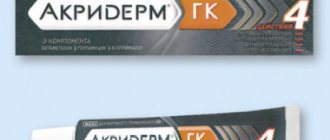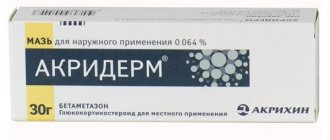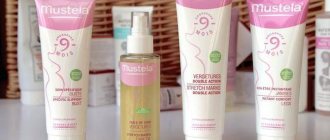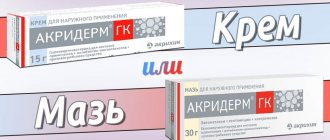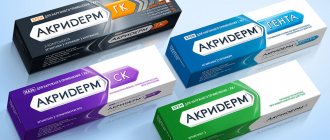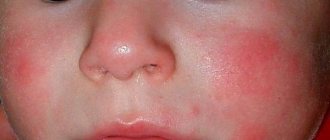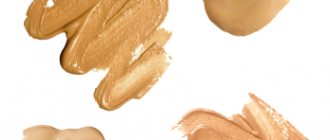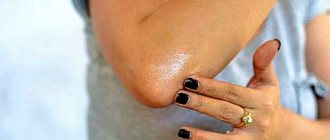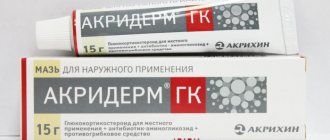Pharmacological action Akriderm GK
The combined drug Akriderm GK has antifungal, anti-inflammatory, antibacterial and antiallergic properties due to the main active ingredients of the drug - clotrimazole, gentamicin and betamethasone dipropionate.
Clotrimazole is an antifungal agent from the group of imidazole derivatives; its effect is expressed in disrupting the synthesis of the main fungal sterol - ergosterol (vitamin D2). It is active against Microsporumcanis, Trichophytonmentagrophytes, Malasseziafurtur, Trichophytonrubrum, Candidaalbicans and Epidermophytonfloccosum.
Betamethasone dipropionate is a glucocorticosteroid with antiexudative, anti-inflammatory, antiedematous, antiallergic and antipruritic properties, as well as:
- Inhibiting the accumulation of leukocytes;
- Releases lysosomal enzymes and pro-inflammatory mediators at the site of inflammation;
- Prevents the formation of inflammatory edema;
- Inhibiting phagocytosis;
- Reducing vascular tissue permeability.
Gentamicin is an antibiotic from the group of aminoglycosides with a broad spectrum of action. It is active against such gram-negative bacteria as Proteus vulgaris, Aerobacter aerogenes, Escherichia coli, Pseudomonas aeruginosa, Klebsiella pneumoniae, as well as gram-positive bacteria Streptococcus spp. and Staphylococcus spp.
Properties of the drug
Akriderm is a group of hormonal drugs to combat various skin diseases. It consists of 4 varieties, each of which is a broad-spectrum antimicrobial agent:
- Akriderm ointment and cream contain a hormonal agent and are recommended for uncomplicated skin pathologies: contact dermatitis, itchy skin, psoriasis.
- Due to the gentamicin content, GC ointment and cream have an antimicrobial effect. Used to treat simple and allergic dermatitis complicated by secondary infection, neurodermatitis, eczema and lichen.
- SK ointment contains salicylic acid. Recommended for diseases whose development is accompanied by tissue suppuration: psoriasis, dermatosis, eczema, lichen planus, ichthyosis.
- Genta in the form of ointment and cream is indicated for the treatment of atopic dermatitis and eczema, psoriasis, and solar dermatitis.
Of all the varieties of the drug, Akriderm GK has become the most popular due to its complex effects. The active components in the composition provide its antimycotic, anti-inflammatory, antiallergic and antibacterial activity.
The drug contains the following active ingredients:
- Gentamicin is a substance with antimicrobial and antibacterial effects.
- Betamethasone is a hormone of synthetic origin. Stops the development of inflammation, relieves swelling and allergic rashes on the skin.
- Clotrimazole is a substance with a pronounced antimycotic effect and has a negative effect on many types of fungi.
Additional substances in the cream:
- Propylene glycol.
- Petrolatum.
- Disodium edetate.
- Stearyl and cetostearyl alcohols.
- Trilon V.
- Macrogol cetostearate.
- Liquid paraffin.
- Purified water.
The composition of the ointment is supplemented with nipazole, liquid paraffin and petroleum jelly.
Some auxiliary components in both drugs have antiseptic properties and stop inflammation. They are able to enhance and prolong the effect of active ingredients due to the gradual complete absorption of the hormone.
Both forms of the drug Akriderm GK are indicated for the treatment of skin diseases caused by fungi, accompanied by skin itching and secondary bacterial infection. The regimen is identical. The products are applied to areas with affected skin twice a day. The duration of the course of treatment is determined by the doctor.
Akriderm GK ointment is indicated for the treatment of skin diseases caused by fungi, accompanied by skin itching and secondary bacterial infection.
Since all medicines from the Akriderm group contain hormonal substances and an antibiotic, they can only be used after consultation with a doctor.
In ointment form
Due to the high penetrating ability of the ointment, it is recommended for use in the treatment of chronic forms of inflammation.
In the form of a cream
The cream form has a lighter structure. Therefore, it is most often used to eliminate problems on the surface of the skin, and is recommended for use in acute inflammation as a moisturizer and cooling agent.
Release form
In accordance with the instructions, Akriderm GK is produced in the form of a white or almost white cream, 15 and 30 g in aluminum tubes.
One gram of Akriderm GK cream contains 1 mg of gentamicin sulfate, 640 mcg of betamethasone dipropionate and 10 mg of clotrimazole, as well as such excipients as:
- Vaseline and sodium dihydrogen phosphate dihydrate;
- Medical Vaseline oil;
- Propylene glycol and purified water;
- Cetostearyl alcohol and Trilon B;
- Macrogol cetostearyl ether.
Akriderm GK is also produced in the form of a white or almost white ointment, in aluminum tubes of 15 or 30 g. One gram of Akriderm GK ointment contains 1 mg of gentamicin sulfate, 10 mg of clotrimazole and 640 mcg of betamethasone dipropionate, as well as the following excipients:
- Petrolatum;
- Propyl parahydroxybenzoate;
- Liquid paraffin;
- Isopropyl myristate.
Pharmacological properties of Akriderm GK
The dermatological product has several actions at once - it relieves inflammation, allergic skin reactions, and suppresses fungal and bacterial infections. The therapeutic effect is achieved due to the inclusion of three strong components:
- Gentamicin is an antibiotic substance. Suppresses many pathogenic organisms belonging to the gram-negative group.
- Betameson is a corticosteroid, slows down inflammatory processes, reduces the permeability of blood vessels and tissues, and blocks the formation of inflammatory swelling.
- Clotrimazole has antifungal properties and belongs to the imidazoles. Causes destruction of the pathogen and thereby suppresses the development of infection. Affects mold and yeast fungi, dermatophytes.
Thanks to the strong properties of the active ingredients, Akriderm GK can be called heavy artillery, because it is usually prescribed in difficult cases - in severe or advanced forms of the disease.
Depending on the indications, Akriderm GK ointment or cream is used; the preparations differ in structure: in the first case, the auxiliary agents are petroleum jelly and petroleum jelly, purified paraffin. The structure of the cream is made up of propylene glycol, water and paraffin.
Akriderm GK is used for:
- Simple or allergic dermatitis
- Diffuse neurodermatitis
- Lichen simplex
- Eczema
- Dermatomycosis of various localizations
- Psoriasis.
If the doctor deems it necessary, he may prescribe the drug for the treatment of acne. But it is not recommended to use such a powerful hormonal drug on your own. The appointment should be made by an experienced specialist after determining the etiology of acne and examining the patient. It is possible that in addition to external agents, systemic treatment with tablets or injections will be needed.
Detailed instructions are available at the link:
Side effects
According to reviews, Akriderm GK in some cases causes irritation, folliculitis, burning, dry skin, hypertrichosis, acne-like rashes, hypopigmentation, allergic contact and perioral dermatitis.
Also, Akriderm GK, according to reviews, with long-term use or use in combination with occlusive dressings causes atrophy and maceration of the skin, purpura and secondary infection. Application of the product to a large area of skin can lead to the appearance of symptoms of Cushing's syndrome, glucosuria, hyperglycemia and reversible inhibition of adrenal function.
Mode of application
The success of acne treatment depends primarily on the correct diagnosis. This will help not only get rid of them, but also destroy the cause of their occurrence. If the dermatologist decides that they can be dealt with using Akriderm GK, he will prescribe a course of treatment with ointment or cream. If therapy follows a standard regimen and no individual adjustments to the treatment regimen are required, then the product is used according to the manufacturer’s instructions.
The medicine is applied to the affected areas in a transparent layer, lightly rubbing into the surface. It is important to ensure that the drug does not get on the mucous membranes of the mouth, nose, and especially the eyes. The procedures are carried out in the morning and evening.
It is not recommended to cover treated areas with bandages. Since the drug is oily, it requires exposure to oxygen, and in its absence, Akriderm GK does not penetrate the skin well. Using tight bandages can cause a rash or prickly heat.
Skin lesions are usually treated with Akridem for 2-4 weeks, and treatment for pimples on the face takes no more than 5-7 days. It is not recommended to use Akriderm for longer than this time. Otherwise, the risk of side effects and complications increases.
If after this time the acne has not cleared up, you will need to make a follow-up visit to your dermatologist to determine further steps. It may be necessary to clarify the diagnosis or apply other methods of therapy.
Special instructions for Akriderm GK
The product is not intended for ophthalmic use; it is important to ensure that it does not come into contact with the eyes.
When prescribing the drug to children over the age of 2 years, it is necessary to take into account that, unlike adults, the area of their skin in relation to body weight is much larger, and the epidermis is not sufficiently developed. Due to this, there is a risk of absorption of a larger amount of the main active ingredients of Akriderm GC, which may result in atrophic changes in the skin and systemic adverse reactions. In this regard, it is important to follow all precautions specified by the manufacturer and use the product in children for the shortest possible time.
If a hypersensitivity reaction, persistent fungal or bacterial microflora, or skin irritation occurs, Akriderm GK should be discontinued and appropriate symptomatic therapy should be prescribed. In cases of long-term use of the drug, the manufacturer recommends gradually discontinuing it.
What is the difference between cream and ointment Akriderm GK
The main differences between the two dosage forms are the quantitative composition of additional components, as well as their penetrating ability.
Compound
The difference lies in the composition of the auxiliary components that are used to structure the base.
How they work
Due to the presence of fatty substances in the composition, the ointment has a denser structure. After its application, a film remains on the skin, facilitating more active penetration of the main active components into the tissue. The ointment can penetrate into the deep layers of the skin and even enter the bloodstream.
The cream has a lighter texture. It does not leave a greasy film, does not penetrate deep into the tissue and does not enter the bloodstream. Due to the large amount of water in its composition, the creamy substance moisturizes the skin well and cools.
Contraindications and side effects
It is contraindicated to use both dosage forms for severe dermatological diseases, skin tuberculosis, skin manifestations of syphilis, chicken pox and herpes simplex.
The drug is not used to treat pregnant women and nursing mothers, as well as children under 2 years of age.
The hormonal compound in the product requires strict adherence to the doctor’s recommendations. Exceeding the dosage can cause side effects, which may manifest as small blisters, redness, and swelling on the skin.
In rare cases it is noted:
- Headache, severe fatigue.
- Sleep disturbance.
- Malfunctions of the digestive system.
It is not recommended to use Akriderm GK in the treatment of facial skin diseases. In case of urgent need, apply carefully, avoiding contact with eyes and mucous membranes.
Long-term use of both forms of the product can cause inflammation of the hair follicles and pigmentation disorders.
Which is cheaper?
Both dosage forms have the same cost.
Contraindications to treatment with Akriderm
It is prohibited to apply the drug to the skin and face if the patient has:
- open wounds;
- post-vaccination manifestations;
- herpes simplex;
- chickenpox;
- epithelial tuberculosis;
- syphilis.
Also, it is not recommended to use the cream to treat rashes on the body and face in adult patients with hypersensitivity to the components of Akriderm, and in children under two years of age. Under the strict supervision of a doctor, it is allowed to treat children aged 2-18 years with Akriderm.
Contraindications
Before use, you should definitely consult with a competent dermatologist.
The drug is contraindicated if:
- you are pregnant or breastfeeding. During this period, a change occurs at the hormonal level, as a result of which the body’s protective functions are weakened;
- chicken pox was detected. The product will not help you get rid of inflammation caused by chickenpox, but will only worsen the skin condition;
- there are wounds, ulcers and open inflammations.
The drug is also contraindicated in infants under one year of age and people who have been diagnosed with rosacea. Find out about the features of using Dalex-acne gel for acne by following the link.

